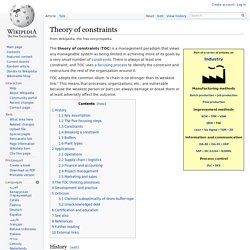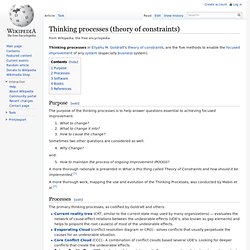

Theory of constraints. The theory of constraints (TOC) is a management paradigm that views any manageable system as being limited in achieving more of its goals by a very small number of constraints.

There is always at least one constraint, and TOC uses a focusing process to identify the constraint and restructure the rest of the organization around it. TOC adopts the common idiom "a chain is no stronger than its weakest link. " This means that processes, organizations, etc., are vulnerable because the weakest person or part can always damage or break them or at least adversely affect the outcome. History[edit] An earlier propagator of the concept was Wolfgang Mewes[2] in Germany with publications on power-oriented management theory (Machtorientierte Führungstheorie, 1963) and following with his Energo-Kybernetic System (EKS, 1971), later renamed Engpasskonzentrierte Strategie as a more advanced theory of bottlenecks. Thinking processes (theory of constraints) Thinking processes in Eliyahu M.

Goldratt's theory of constraints, are the five methods to enable the focused improvement of any system (especially business system). The purpose of the thinking processes is to help answer questions essential to achieving focused improvement: The Theory of Constraints and its Thinking Processes.
Strategic and Tactic. Software.